#king william ii of württemberg
Text

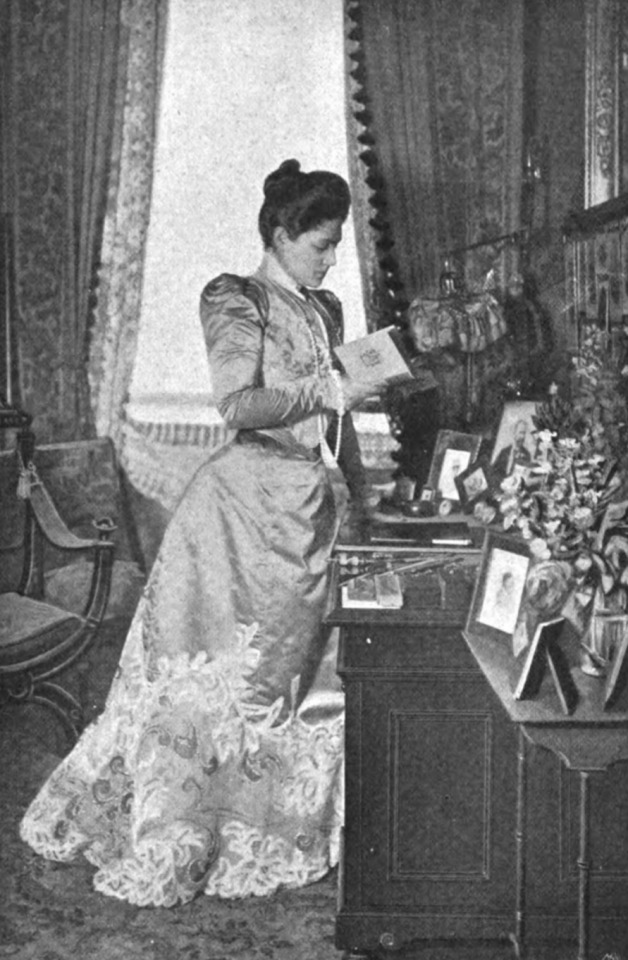
King William II and Queen Charlotte of Württemberg, 1900.
#king william ii of württemberg#queen charlotte of württemberg#württemberg#german royal#german royalty#1900s#1900
23 notes
·
View notes
Text
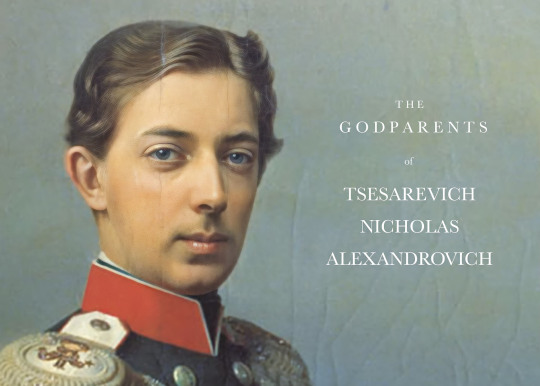
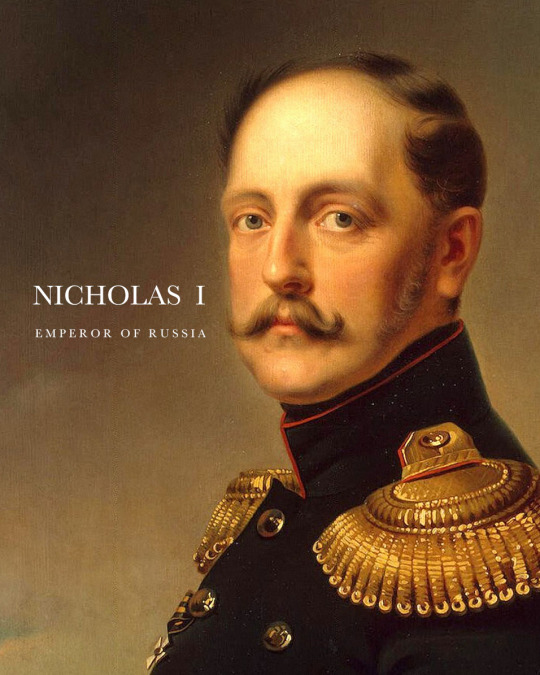
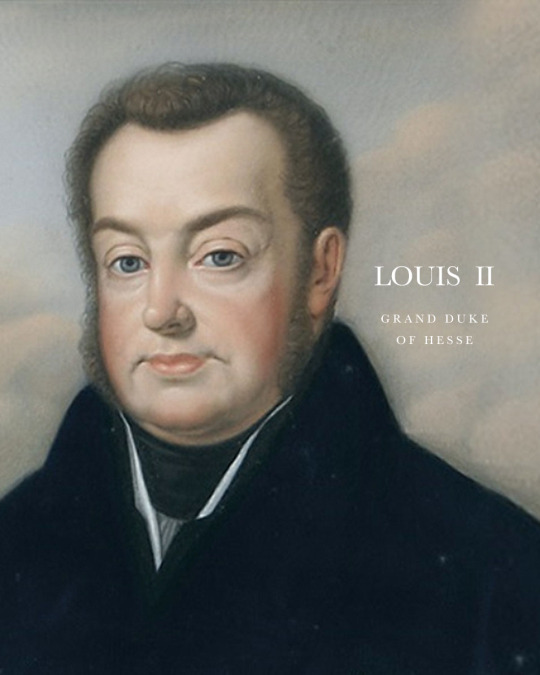


GODPARENTS OF TSESAREVICH NICHOLAS ALEXANDROVICH
Tsesarevich Nicholas Alexandrovich was born as Grand Duke of Russia during the reign of his formidable grandfather Emperor Nicholas I on 20th September 1843. He was the eldest son and second child born to Emperor Alexander II (then Tsesarevich) and his wife Empress Maria Alexandrovna. He was christened in the Grand Palace Church, Tsarskoe Selo, by the Confessor of His Imperial Majesty. He had four known godparents as listed:
NICHOLAS I, EMPEROR OF RUSSIA - his paternal grandfather and namesake was one of his godparents present at his christening. Mainly remembered in history as a reactionary whose controversial reign was marked by geographical expansion, centralisation of administrative policies and repression of dissent. He died in 1855, when the younger Nicholas was only 11 years-old, and thus making him the heir apparent (Tsesarevich).
LOUIS II, GRAND DUKE OF HESSE AND BY RHINE - his maternal grandfather was another of his godparents, but was absent at the christening. The hessian grand duke, like his paternal grandfather, was also considered a reactionary leader, he was in conflict with parliament almost his entire reign. The German revolution in 1848-49 proved his inability to govern. On March 5, 1848 he named his son Louis III as co-regent, and a year later he died.
GRAND DUCHESS ANNA PAVLOVNA OF RUSSIA, QUEEN CONSORT OF THE NETHERLANDS - his great-aunt was the third listed as godparent of the young grand duke, but was also absent at the christening. Queen Anna, the favourite sister of Emperor Nicholas I of Russia and the consort of King William II of the Netherlands, was a Russian patriot who upheld a strict royal etiquette in the Netherlands, where she never felt at home, and identified more as an Imperial Grand Duchess than a Dutch queen. She had no political influence, but was active within charity.
GRAND DUCHESS OLGA NIKOLAEVNA OF RUSSIA, QUEEN CONSORT OF WÜRTTEMBERG - his aunt was one of his godparents present at the christening. She was the younger sister of his father. Attractive, cultured and intelligent, she was considered to be one of the most eligible princesses in Europe. Just three years after her nephew was born, in 1846, she married Crown Prince Karl of Württemberg. Nicholas died just two months before seeing his aunt Queen consort of Württemberg.
Source
9 notes
·
View notes
Photo


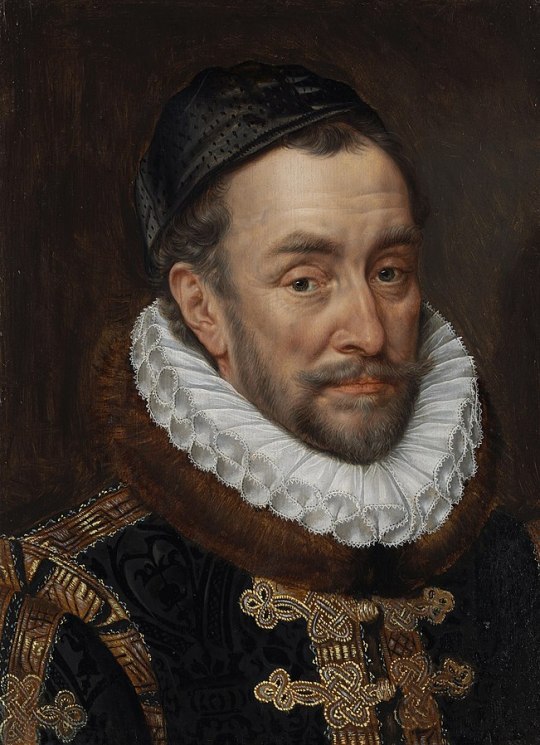



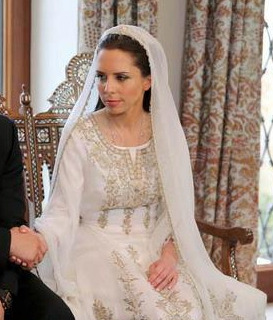
Royal Birthdays for today, April 24th:
Ramiro II, King of Aragon, 1086
Sabina of Bavaria, Duchess of Württemberg, 1492
William the Silent, Prince of Orange, 1533
Gaston, Duke of Orléans, 1608
Maria Clementina of Austria, Duchess of Calabria, 1777
Marau, Queen of Tahiti, 1860
Iman bint al-Hussein, Princess of Jordan, 1983
#ramiro ii#sabina of bavaria#maria clementina of austria#Queen Marau#Iman bint ِAl-Hussein#gaston of orleans#gaston of france#william the silent#long live the queue#royal birthdays
10 notes
·
View notes
Text
Events 7.12 (before 1900)
70 – The armies of Titus attack the walls of Jerusalem after a six-month siege. Three days later they breach the walls, which enables the army to destroy the Second Temple.
927 – King Constantine II of Scotland, King Hywel Dda of Deheubarth, Ealdred of Bamburgh and King Owain of the Cumbrians accepted the overlordship of King Æthelstan of England, leading to seven years of peace in the north.
1191 – Third Crusade: Saladin's garrison surrenders to Philip Augustus, ending the two-year siege of Acre.
1470 – The Ottomans capture Euboea.
1488 – Joseon Dynasty official Choe Bu returned to Korea after months of shipwrecked travel in China.
1493 – Hartmann Schedel's Nuremberg Chronicle, one of the best-documented early printed books, is published.
1527 – Lê Cung Hoàng ceded the throne to Mạc Đăng Dung, ending the Lê dynasty and starting the Mạc dynasty.
1543 – King Henry VIII of England marries his sixth and last wife, Catherine Parr, at Hampton Court Palace.
1562 – Fray Diego de Landa, acting Bishop of Yucatán, burns the sacred idols and books of the Maya.
1576 – Mughal Empire annexes Bengal after defeating the Bengal Sultanate at the Battle of Rajmahal.
1580 – The Ostrog Bible, one of the early printed Bibles in a Slavic language, is published.
1691 – Battle of Aughrim (Julian calendar): The decisive victory of William III of England's forces in Ireland.
1776 – Captain James Cook begins his third voyage.
1789 – In response to the dismissal of the French finance minister Jacques Necker, the radical journalist Camille Desmoulins gives a speech which results in the storming of the Bastille two days later.
1790 – The Civil Constitution of the Clergy is passed in France by the National Constituent Assembly.
1799 – Ranjit Singh conquers Lahore and becomes Maharaja of the Punjab (Sikh Empire).
1801 – British ships inflict heavy damage on Spanish and French ships in the Second Battle of Algeciras.
1806 – At the insistence of Napoleon, Bavaria, Baden, Württemberg and thirteen minor principalities leave the Holy Roman Empire and form the Confederation of the Rhine.
1812 – The American Army of the Northwest briefly occupies the Upper Canadian settlement at what is now at Windsor, Ontario.
1862 – The Medal of Honor is authorized by the United States Congress.
0 notes
Text
Tiara Exhibition in Stuttgart
There’s a new exhibition about King William II of Württemberg at the StadtPalais Museum in Stuttgart, Germany that features the beautiful pink topaz parure that belonged to his first wife, Princess Marie. The parure currently belongs to the Albion Art Institute and they have loaned it the museum. The exhibition is open until March 27th and you can find out more about visiting here.
Princess Marie of Württemberg's Pink Topaz Parure


#tiara exhibition#Princess Marie#Wurttemberg#Wurttemberg Royal Family#Germany#German Royals#pink topaz#pink#Duchess of Wurttemberg#topaz#tiara#tiaras#diadem#diadems#royal tiaras#jewels#royal jewels#royal#royals#royalty#jewellery#jewelry#crown#crowns#crown jewels
184 notes
·
View notes
Note
We’re there any royals/people of importance in government history that married someone of the same sex? Happy pride!
Not marry but there have been loads of LGBTQI+ Royals!
Philippe, Duke of Orleans
Richard I
Edward II
Ying Shao
James VI & I
William Rufus/ William II
Juilus Caesar
Philip II of France
Hyegong of Silla
Felix Yuspov
Ferdinando II de' Medici, Grand Duke of Tuscany
Emperor Elagabalus
Lord Ivar Mountbatten
Princess Isabella of Bourbon-Parma
Archduchess Maria Christina
Anne I
Emperor Tongzhi
Charles, King of Württemberg
Fredrick the Great
Emperor Hadrian
Emperor Galba
Emperor Nero
Mark Antony
Emperor Ai of Han
59 notes
·
View notes
Text
Charlotte Returns to Weymouth
Charlotte Returns to Weymouth

At first Charlotte found it easy enough to follow the advice to be patient with her father. But it was not so easy to be patient with Leopold. As soon as she reached Weymouth, she wrote to Mercer telling her that ‘the Leo’ was in Paris, and begging her to write to him, although she added, ‘Preach up prudence. A false step now I feel would ruin all.’
In the weeks and then months that followed,…
View On WordPress
#alexander I tsar of russia#amelia (emily) stewart viscountess castlereagh#charlotte&leopold#george IV (prince of wales and prince regent)#grand duchess anna pavlovna queen of the netherlands#grand duchess catherine pavlovna duchess of oldenburg and queen of württemberg#james chambers#lieutenant charles hesse#prince augustus of prussia#prince leopold of saxe-coburg-gotha (later king of the belgians)#princess charlotte of wales#the hon.margaret mercer elphinstone#weymouth#william II of the netherlands (hereditary prince of orange)
0 notes
Photo

Princess Charlotte of Schaumburg-Lippe was the daughter of Prince Wilhelm Karl August of Schaumburg-Lippe, and his wife, Princess Bathildis of Anhalt-Dessau. As the second wife of King William II of Württemberg she became Queen consort of Württemberg. She was not only the last queen of Württemberg, but the last surviving queen of any German state.
11 notes
·
View notes
Text

In 1669, the Count of Hanau, Friedrich Casimir, began preparations to purchase territory in Guiana from the Dutch West India Company. Initially, it looked as though this deal would fall through and the Count would be driven into bankruptcy, but before this happened, he received generous donations from various minor nobles both in his court and abroad, allowing the deal to go through. After 3 years of negotiations with the West India Company, Friedrich Casimir purchased the lands between the Courantyne and Amazon Rivers, an area of roughly 100,000 square kilometres, many times the size of the tiny County of Hanau.
After the purchase, he sent roughly 500 colonists, mainly from his county, but there included a small number of colonists from neighbouring countries, to his newly obtained colony. Originally, the plan had been to name the land the Hanauisch-Indien, or Hanauish Indies, but after several months, the land was renamed to Neu-Hanau and the capital at the mouth of the Suriname River being named Friedrichsburg, and sometimes called Paramaribo after a native word meaning “inhabitants of the large river”. As a part of the deal, the Dutch West India Company was given a total monopoly on shipping between Europe and Neu-Hanau.
Not long after the land was transferred to Hanauish authority, the Third Anglo-Dutch War broke out, and shipping to the new colony ceased. The colonists sent by the county on Dutch ships had been forced to land in the Portuguese New World territories of Brazil and take a smaller boat up the coast to the land planned for Friedrichsburg. Many believed the colony wouldn’t make it through the war, but somehow they managed to survive.
After the Third Anglo-Dutch War ended in 1674, shipping renewed, and another wave of colonists arrived in Friedrichsburg, now a small settled village. Initially, the village had some major troubles, including a number of famines, but after two decades, the colonial capital had stabilised.
On March 30th, 1685, Count Friedrich Casimir died without issue, and his nephew, the minor Philipp Reinhard, became the new Count. His reign would begin 2 years later in 1687. His reign would be a relatively prosperous one for the small county and its new colony. One of his first acts as Count was to make a visit to Friedrichsburg, and stay there for about a year, ruling from the tiny village that acted as the colonial capital. He had planned to stay longer, but was stricken with Malaria and had to return to Europe, where he recovered.
Under Philipp Reinhard, the colony of Neu-Hanau tripled in population, as he continued to offer incentives to people to move to the New World. At this time, the majority of the colony’s income was from its sugar plantations, rum distilling, lumber, and coffee. The economy of the colony existed at the time mainly on the backs of slaves, and conditions for these slaves was often harsher than in other colonies. Many of the slaves managed to escape to the jungles and establish contact with native tribes, forming their own tribes, now known as the Maroons.
During the 9 Years’ War and Spanish succession war, both the colony of Neu-Hanau and the County of Hanau were occupied several times, but both managed to recover after these wars, though it would take a while.
In 1712, Philipp Reinhard was elevated to the title of Duke, though he died shortly afterward at the age of 48 without any surviving children, and his brother Johann Reinhard became Duke. Duke Johann Reinhard ordered the construction of several churches, both at home and in the colony of Neu-Hanau, as well as founding two new towns in the New World: Philippsburg and Johannesburg.
In 1736, Duke Johann Reinhard died at the age of 70, and like the last two rulers of Hanau and Neu-Hanau, he died without a male son, and left the title of Duke of Hanau to his grandson, Ludwig, the son of the Landgrave of Hesse-Darmstadt, who was only 17 at the time.
Duke Ludwig was an admirer of King Frederick William I, known as the Soldier King, and joined the Prussian military during the War of the Austrian Succession, sending also some forces from his Duchy to support the Prussian army. The war would last 7 years, and see the colony of Neu-Hanau invaded several times, including having the city of Johannesburg razed to the ground.
After the war, Duke Ludwig began to focus a little more on the colony he had neglected, and established a number of forts at strategic places, as well as strengthening the army both at home in Europe and in Neu-Hanau. In Europe, he also chartered the city of Pirmasens, which he made the capital of his Duchy. He also constructed a number of Lutheran churches.
In October 17, 1768, Duke Ludwig’s father, Landgrave Ludwig VIII of Hesse-Darmstadt died at the age of 77, leaving the Landgraviate of Hesse-Darmstadt to his son, the Duke. Duke Ludwig would continue to rule under the title of Duke of Hanau, and would also continue his military build up of his lands, including the new land of Hesse-Darmstadt, which he incorporated into the Duchy of Hanau.
On April 6th, 1790, Duke Ludwig died at the age of 70 and left his lands to his son, Ludwig II. Ludwig II was more diplomatic than his father, and made constant trips across Europe, including to the court of the Prussian King, Frederick the Great, whose son his sister married, and to the court of Catherine the Great of Russia, whose son and heir his other sister married. He himself was engaged to the daughter of the Duke of Württemberg, but the engagement was called off when his sister Wilhelmina, the wife of Tsarevich Paul, died, and was wed instead to the daughter whom he had previously been engaged to marry. Instead, Duke Ludwig II wed his cousin.
Duke Ludwig II was also a more tolerant person than his predecessors, and ended persecution of Jews and Catholics in his lands, even establishing a Catholic church in Friedrichsburg, Neu-Hanau. Duke Ludwig II’s rule coincided with the French Revolution and the French wars, and he would several times move his court and household to live in Friedrichsburg as the threat of invasion of Hanau was always imminent, and his Duchy lost much of its land on the left bank of the Rhine, the area known as Hanau-Lichtenburg. In 1806, Ludwig II and Hanau joined the Confederation of the Rhine, and was elevated to the title of Grand Duke of Hanau and Hesse by Rhine. In 1816, after the end of the Napoleonic Wars, he was granted additional lands on the left bank of the Rhine. Outside of war and governance, Grand Duke Ludwig also established several libraries, established several scholarships, and promoted theatre and music. He also ordered the drafting of the first constitution for the Grand Duchy.
On April 6th, 1830, exactly 40 years after the death of his father, Grand Duke Ludwig died at the age of 76, leaving his lands to his son, Ludwig II. Grand Duke Ludwig II’s reign wasn’t truly very notable for either the homeland or the colony of Neu-Hanau. The colony was left much to its own devices during the 18 years of his reign, and during this time, the three cities of Friedrichsburg, Philippsburg, and Johannesburg grew quite a bit without much interference. Two smaller cities were established during this time, largely inhabited by natives and Maroons.
In 1848, Europe underwent the great Revolutions, and Hanau-Hesse wasn’t spared from this. Grand Duke Ludwig II, not feeling up to the pressure and stress that the revolution brought abdicated to his son, Ludwig III, dying not long afterward. The reign of Ludwig III was significant, for during this time, the Austro-Prussian war broke out. Grand Duke Ludwig III, wary of the Prussians, sided with the Austrian Empire. After the defeat of the Austrian alliance, Hanau-Hesse was forced to concede Upper Hesse to the Prussians, nearly halving the land of the Grand Duchy in Europe. Also during the rule of Ludwig III, slavery was outlawed in the colony of Neu-Hanau, and settlements were made with now-free slaves and Maroons, and the two cities of Neu-Darmstadt and Neu-Buchsweiler grew significantly as a result of former slaves settling in the two cities.
In 1868, Grand Duke Ludwig III married morganatically, and afterward retired from ruling, leaving the Grand Duchy to his nephew, Ludwig IV. While Grand Duke Ludwig III’s reign had been significant in its own right, the rule of his nephew was even more significant. During his reign, not only did the Franco-Prussian War break out, but the states that made up Germany united under one flag. This, however, was not something accepted by the people of Hanau-Hesse, nor by the Grand Duke and his ministers. As a result, Grand Duke Ludwig IV, with the support of his people, joined the French in their disastrous war. After their defeat, the Grand Duke, his family, court, and a vast number of his people, fled to the colony of Neu-Hanau, which had remained untouched by the war. The Grand Duchy of Hanau-Hesse abandoned its European homeland.
Neu-Hanau was renamed simply Hanau, and construction of a royal palace began in Friedrichsburg. In total, somewhere between 35 and 40 percent of the population of Hanau-Hesse fled Europe for the former colony of Hanau. Most of these refugees settled in the city of Friedrichsburg, though smaller numbers also went to Philippsburg and Johannesburg. The population of Hanau grew from a mere 30,000 to over 1,000,000 in only 4 years. At first, the colony could not sustain that many new mouths to feed, and the country nearly collapsed, but thanks to help from Brazil, the United States, the United Kingdom (Grand Duke Ludwig’s wife was the second daughter of Queen Victoria), and France, Hanau was able to survive.
In 1892, the Grand Duke Ludwig IV died. He was succeeded by his son, Ernst Ludwig. As with his father’s and great uncle’s reigns, Grand Duke Ernst Ludwig’s reign was terribly significant. His reign marked the growth of Hanau as a new, fledgling country in South America, and the growth of modern technology. In 1896, the Royal Palace of Friedrichsburg was outfitted with electricity and electric bulbs. Grand Duke Ernst Ludwig was well connected to the royal families of Europe, particularly those of Russia and the United Kingdom, and would often make visits to these countries. In 1899, he founded a colony for artists in Frierdrichsburg, and gave them great patronage. The colony of Friedrichsburg was noted as a centre of the Art Nouveau style, amongst others. The Grand Duke also established, at the advice of an advisor, a national arms factory, located in Philippsburg. The factory made mostly licensed copies of American and British designs, and still exists today, albeit as an independent company rather than a national company.
In 1914, the world became embroiled in war, and Hanau, as a result of its connections to European powers, was drawn in as well. Grand Duke Ernst Ludwig pledged support to the Allies, sending roughly 600 men to fight in Europe. The Hanauish soldiers distinguished themselves in several battles, but their efforts were largely overshadowed by the fighting done by the larger nations. Grand Duke Ernst Ludwig had hoped that fighting in the war would allow him to take back the lands of Hanau and Hesse that had been taken from his family several decades before, but in the end Hanau had no such luck, and remained a South American country. After the war, many of the monarchies of Germany were abolished, and a great number of nobility fled their countries. Many fled to Hanau, and many were given noble titles as compensation. Several new cities were established with this fresh influx of people, including Corantijn, Nikerie, and Saramacca.
Between WWI and WWII, Hanau was seldom in foreign news. After the abolition of the German monarchies, the surviving German monarchy of Hanau chose to keep much to itself, and focus on its internal politics. The government was restructured to be more modern, though the Grand Duke still retained a great deal of authority, and still does, that most other European monarchs no longer have. In 1923, the Prime Minister of Hanau was elected, replacing the older office of President-Minister; Albrecht Biedermann, of the Vaterländisch Bürgerpartei, the oldest extant party in the Grand Duchy, founded in 1891.
In 1937, Grand Duke Ernst Ludwig died, and his son, Georg Donatus, took the throne. However, his reign would be shortlived, as he and his immediate family were killed in an air accident en route to his brother and heir’s wedding in the United Kingdom. After Georg Donatus’ death, his brother assumed the throne as Grand Duke Ludwig V.
In 1939, World War Two broke out in Europe. During the war, the Grand Duchy remained officially neutral, but in reality they were sending supplies to the British for the duration of the war. The country also took in Jewish and other refugees, especially other former nobles of Germany. The Free French were also allowed to use Hanauish ports to ferry men to and from their African colonies and Europe. Many of the Jewish refugees settled in the city of Johannesburg, which historically was the centre of Jewish community in Hanau.
After WWII, the economy boomed after gold was discovered in the interior of the country, followed by the discovery of bauxite deposits that proved to be very profitable for the country in the wake of the pre-war era’s growing usage of aluminum.
‘’
List of Monarchs:
Count Friedrich Casimir: 1642-1685
Duke Philipp Reinhard (originally Count): 1685-1712
Duke Johann Reinhard: 1712-1736
Duke Ludwig I: 1736-1790
Grand Duke Ludwig I (originally Duke Ludwig II): 1790-1830
Grand Duke Ludwig II: 1830-1848
Grand Duke Ludwig III: 1848-1868
Grand Duke Ludwig IV: 1868-1892
Grand Duke Ernst Ludwig: 1892-1937
Grand Duke Georg Donatus: 1937
Grand Duke Ludwig V: 1937-1968
Grand Duke Philipp (of House Hesse-Kassel): 1968-1980
Grand Duke Moritz: 1980-2013
Grand Duke Donatus: 2013-current
List of Prime Ministers:
Albrecht Biedermann, VBP, 1923-1927
Alexander Freiherr von Philippsburg, VBP, 1927-1932
Marcus Siemens, VBP, 1932-1937
Joachim Biedermann, VBP, 1937-1947, brother of Albrecht Biedermann
Philipp Lorenz, VBP, 1947-1952
Adam Ulrich, DP, 1952-1957
Albrecht Biedermann the Junior, VBP, 1957-1962, son of Albrecht Biedermann
Ludwig, Landgraf von Corantijn, VBP, 1962-1967
Philipp Enzensberger, VBP, 1967-1972
Ludwig, Landgraf von Corantijn, VBP, 1972-1977, second time
Marcus I zu Solms-Braunfels-Nikerie, VBP, 1977-1987
Daniel Lorenz, VBP, 1987-1992, grandson of Philipp Lorenz
Albrecht, Landgraf von Corantijn, VBP, 1992-1997, son of Ludwig
Ludwig Biedermann, VBP, 1997-2002, youngest brother of Albrecht Biedermann the Junior
Lukas Augustus Freiherr von Philippsburg, VBP, 2002-2007, great grandson of Alexander frv Philippsburg
Marcus II zu Solms-Braunfels-Nikerie, VBP, 2007-2012, son of Marcus I
Thomas Biedermann, VBP, 2012-2017, son of Albrecht Biedermann the Junior
Thomas Lorenz, VBP, 2017-current, son of Daniel Lorenz
VBP: Vaterländisch Bürgerpartei; DP: Demokratische Partei (1945-1963)
14 notes
·
View notes
Photo


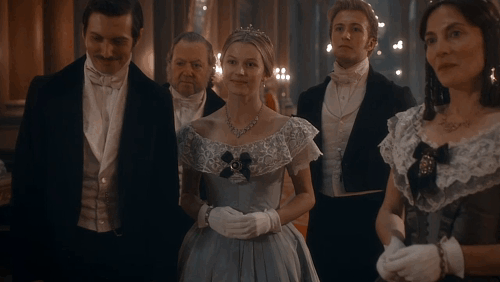
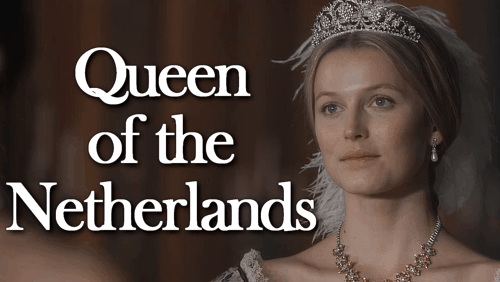

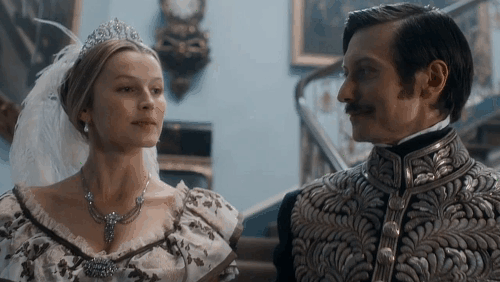


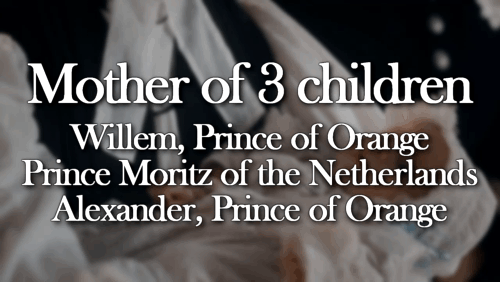
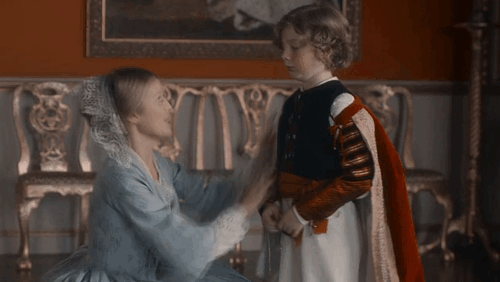
House of Württemberg & of Nassau: Princess Sophie of Württemberg
Sophie was born as the second child and daughter of King Wilhelm I. of Württemberg and his second wife and first cousin Grand Duchess Catharina Pavlovna of Russia. Sophie’s only full sibling is her older sister Princess Marie Friederike Charlotte, Countess of Neipperg. Through her mother’s first marriage, she is also the younger half-sister of Duke Peter of Oldenburg and by her father’s third marriage, she is the older half-sister to Princess Kathrina Friederike (the mother of King Wilhelm II. of Württemberg), King Karl of Württemberg and Princess Auguste, Princess Hermann of Saxe-Weimar-Eisenach.
Since Sophie’s mother died six months after her birth, her father’s sister Queen Katharina of Westphalia raised her. Before it was decided that she shall marry The Prince of Orange, King Otto I of Greece and Duke Wilhelm of Brunswick had asked for her hand. Sophie’s father considered the new Greek monarchy as too instable (his own daughter Katharina had only been Queen of the newly established Kingdom of Westphalia for six years) and to Wilhelm of Brunswick he announced that Sophie was already engaged.
On June 18th, 1839, Sophie married Williem, Prince of Orange. They were first cousins via their mothers Katharina and Anna Pavlovna. The marriage itself was unhappy but it resulted in three princes: Willem, Moritz and Alexander. All of them would die before succeeding to the throne. In the end, it went to their younger half-sister Wilhelmina.
Sophie openly spoke about disliking and feeling superior to her husband. She thought him an unsuitable king and imagined herself to be a better regent for her son. As unhappy as she was, she even tried to get out of the marriage but a divorce was refused. From 1855, the couple lived in seperate castles and she often visited her family in Stuttgart.
While her marriage was definitely not a success, Sophie was not hiding from the public or neglecting her queenly duties. She was a patron of various arts, supported charities and animal protection and funded the construction of public parks. One of her favourite past times was corresponding with scholars all over Europe. Among her pen pals were also Emperor Napoleon III, a nephew-by-marriage of her aunt Katharina who had raised Sophie, and Queen Victoria.
Sophie died on June 3rd, 1877, at the age of 58. She requested to be buried in her wedding dress because that was, according to her, the day her life had ended. Her husband William would marry again. His second wife was Emma of Waldeck and Pyrmont, who was 40 years younger than Sophie. She would become the mother and regent of Queen Wilhelmina of the Netherlands.
// Lily Travers in Victoria (2016-)
#historyedit#German history#Dutch history#women in history#European history#1800s#19th century#Victorian era#House of Württemberg#House of Orange-Nassau#House of Nassau#Women of the House of Württemberg#Princess Sophie of Württemberg#Queen Sophie of the Netherlands#historic women
166 notes
·
View notes
Text
Wonderful! Thank you😊❤️❤️❤️❤️❤️
British Royal family orders
The honour is given by the the British sovereign to female members of the royal family as a reward for their service. The badge usually includes a small portrait of the monarch painted on ivory, surrounded by diamonds, and placed over a ribbon, and is only worn at formal events,
Throughout the years the colour of the ribbon has been changed with each sovereign selecting their own distinctive colour.
The Order is customarily worn on the left side of the lady’s evening gown but there has been the occasional exception to this rule. If the lady has received more than one of the Royal Family Orders from various sovereigns the Orders are worn layered with the most recent one on the top.
the Queen Mother wearing the Order of her daughter, Queen Elizabeth II, on the top and the Order of her husband, King George VI, on bottom.
Queen Elizabeth wearing the Order of her father, King George VI, on the top and the Order of her grandfather, King George V, on the bottom.
Queen Mary was one of the most honoured women of the Royal Family having receiving five Royal Family Orders. The Orders were given by Queen Victoria, King Edward VII, King George V, King George VI and Queen Elizabeth II. The last Order she received was to her given in December 1952 which was after her grand-daughter, Queen Elizabeth’s accession but before her coronation.
Royal Family Order of King George IV
rct
During Prince George’s regency as the result of the madness of his father King George III, the Prince is noted to on special occasions give his personal badge of honour as a memento to the gentlemen and ladies of the court. After the death of his farther and his accession to the throne as King George IV he reserved the honour of the first official Royal Family Order to be given exclusively to female members of the Royal Family.
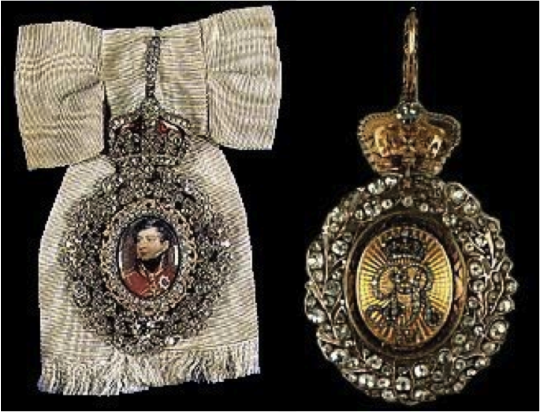
Attached to a white silk bow was a miniature portrait set in a gold and silver frame decorated with diamond oak leaves and acorns with a diamond embellished crown at the top of the frame (as shown in the photo below, the right photo shows the reverse side of the portrait frame). Some of the recipients of the Royal Family Order of King George IV included his sister Queen Charlotte of Württemberg, his sister-in-law Princess Augusta the Duchess of Cambridge and his niece Princess Victoria of Kent who was later to become Queen Victoria.
King William IV
During the reign of King William IV he did not create a formal Royal Family Order but instead issued a set of square jewelled buckles featuring the crowned monograms of King William and Queen Adelaide.
Queen Victoria
rct
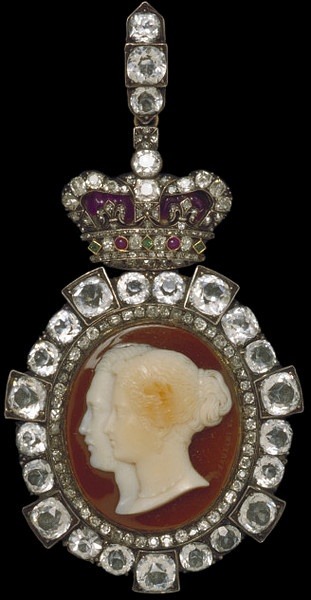
During Queen Victoria reign, her Royal Badge was initially given as her personal honour to her eldest daughter Princess Victoria on the solemn occasion of her confirmation marking her religious commitment and most notably her status as a young adult. In the following years Queen Victoria bestowed the badges on her other daughters also at the time of their confirmations.
Then after the death of her beloved husband Prince Albert, the Queen decided to formally create the Order of Victoria & Albert as another one of her numerous ways of honouring the Prince. Unlike the other Royal Family Orders, the Order of Victoria & Albert was divided into four classes, the first being given her daughters and later her daughters-in-law and grand-daughters with subsequent classes issued to other members of the Royal Family and the Royal Household including honoured servants and couriers.
Both Princess Alexandra, Queen Victoria’s daughter-in-law (later to become Queen Alexandra in 1863) and Princess May of Teck (later to become Queen Mary in 1893) wore their Order of Victoria & Albert badges on their wedding days to the future Kings of England.
The Order of Victoria & Albert was established in 1862 and features an ivory coloured cameo of Queen Victoria and Prince Albert set in brown onyx with a silver gilt frame accented with diamonds, rubies and emeralds with a diamond embellished crown at the top of the frame which was attached to a white silk bow , as shown in the photo below on the left. Lesser class badges were decorated with pearls instead of diamonds.
King Edward VII
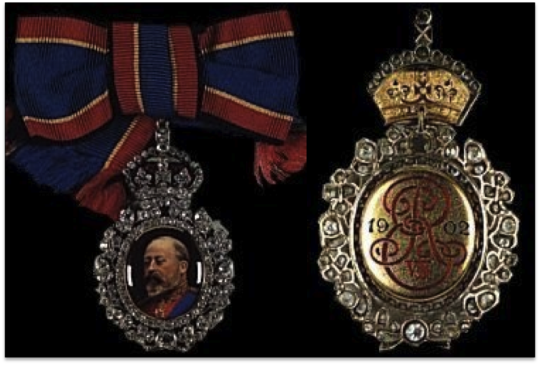
The Royal Family Order of King Edward VII was established in 1901 and features a diamond surrounded miniature portrait of King Edward painted on enamel with a diamond embellished crown at the top of the frame, this would set a precedence for future orders which would be created in this style with a single portrait of the sovereign painted on enamel.
The King Edward portrait frame is attached to a bow in blue, yellow and red stripes which were coincidentally used as King Edward’s horse racing colours, the order is shown in the photo below. The King’s wife Queen Alexandra, his sisters, daughters and daughter-in-law were recipients of King Edward’s Royal Family Orders.
King George V
The Royal Family Order of King George V was established in 1910 and features a miniature portrait of the King painted on enamel surrounded by diamonds with a diamond embellished crown at the top of the frame which is attached to white silk bow.

The recipients of the Order include the King’s wife Queen Mary, his daughter-in-law Princess Alice the Duchess of Gloucester and his two grand-daughters, Princess Elizabeth (later to become Queen Elizabeth II) and Princess Margaret.
King George VI
The Royal Family Order of King George VI was established in 1936 and features a miniature enameled portrait of the King surrounded by diamonds with a diamond embellished crown at the top of the frame which is attached to a rose pink bow.
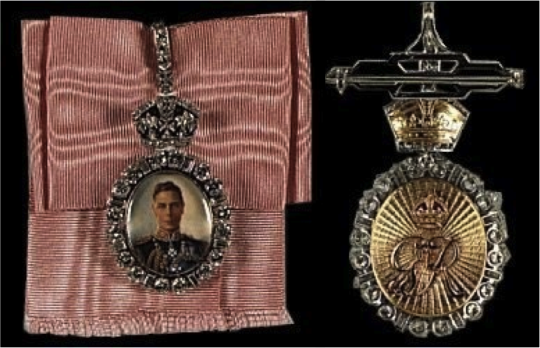
The recipients of the Order include the King’s wife Queen Elizabeth (later known as the Queen Mother) and their eldest daughter Princess Elizabeth (later to become Queen Elizabeth II) and their youngest daughter Princess Margaret (later known as the Countess of Snowdon).
Queen Elizabeth II
The Royal Family Order of Queen Elizabeth II was established in 1952 features a miniature enamelled portrait of the young queen surrounded by diamonds with a diamond embellished crown at the top of the frame which is attached to a chartreuse yellow bow. The reverse side of the Order has the Queen Royal cipher and St. Edward’s Crown in gold and enamel.
The portrait of Queen Elizabeth used for the Royal Family Order is the 1952 painting by Dorothy Wilding
The Queen Elizabeth’s Royal Family Order recipients is the longest list.
46 notes
·
View notes
Text

Prince William of Württemberg and his fiancée, Princess Marie of Waldeck and Pyrmont, c. 1877.
#king william ii of württemberg#princess marie of waldeck and pyrmont#württemberg#german royal#german royalty#1877#1870s#royal engagement
17 notes
·
View notes
Text



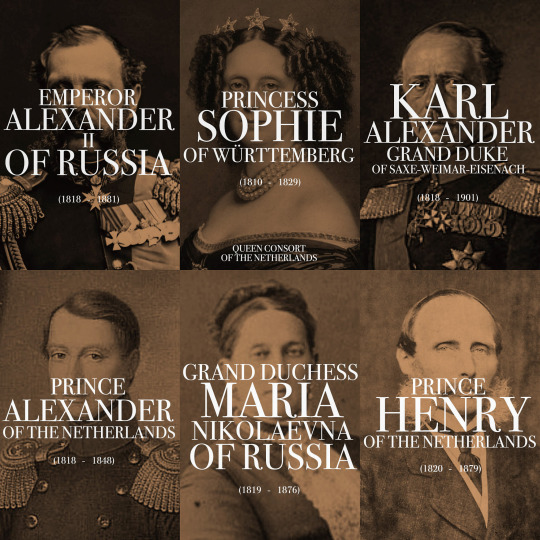


The Grandchildren of Emperor Paul I
Emperor Paul I of Russia had at least 30 legitimate grandchildren -23 survived to adulthood. Two of whom became reigning monarchs [Emperor Alexander II of Russia and King William III of the Netherlands]. Another two became Queen consorts of the Netherlands [Princess Sophie of Württemberg] and of Württemberg [Grand Duchess Olga Nikolaevna of Russia].
Among the 23 grandchildren that survived to adulthood, 16 of them have living descendants today. This includes King Willem-Alexander of the Netherlands, King Felipe VI of Spain, Queen Margrethe II of Denmark, King Carl XVI Gustaf of Sweden, and the Prince of Wales.
*Notes: Grand Duchess Maria Alexandrovna and Grand Duchess Elizabeth Alexandra were rumoured to have different fathers, but Tsar Alexander I recognised them. **Four of Emperor Paul’s grandchildren married each other: King William III of the Netherlands & Princess Sophie of Württemberg; and Karl Alexander, Grand Duke of Saxe-Weimar-Eisenach & Princess Sophie of the Netherlands.
#emperor paul#alexander ii#maria nikolaevna#olga nikolaevna#alexandra nikolaevna#konstantin nikolaevich#nicholas nikolaevich#michael nikolaevich#relatives#grandchildren#myedits#elizabeth mikhailovna#catherine mikhailovna#others
41 notes
·
View notes
Photo

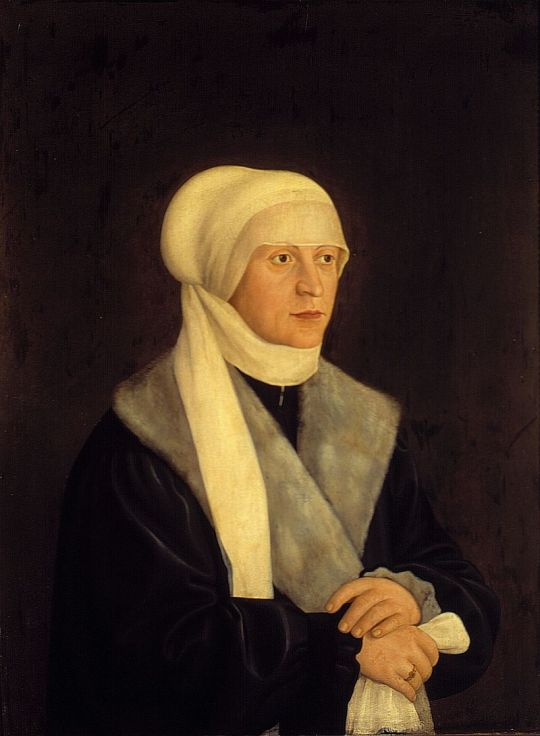
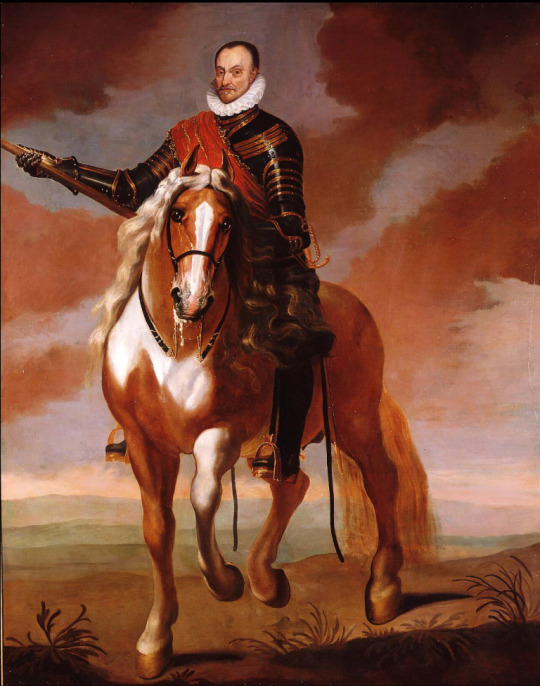

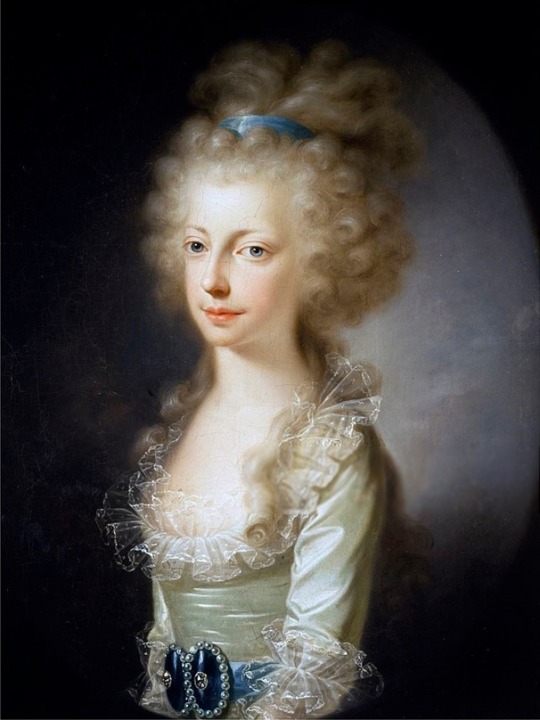

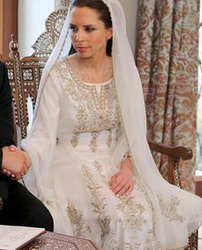
Royal Birthdays for today, April 24th:
Ramiro II, King of Aragon, 1086
Sabina of Bavaria, Duchess of Württemberg, 1492
William the Silent, Prince of Orange, 1533
Gaston, Duke of Orléans, 1608
Maria Clementina of Austria, Duchess of Calabria, 1777
Marau, Queen of Tahiti, 1860
Iman bint al-Hussein, Princess of Jordan, 1983
#Maria Clementina of Austria#ramiro ii#sabina of bavaria#william the silent#Queen Marau#gaston of orleans#Iman bint ِAl-Hussein#royal birthdays#long live the queue
20 notes
·
View notes
Text
Events 7.12
70 – The armies of Titus attack the walls of Jerusalem after a six-month siege. Three days later they breach the walls, which enables the army to destroy the Second Temple.
927 – King Constantine II of Scotland, King Hywel Dda of Deheubarth, Ealdred of Bamburgh and King Owain of the Cumbrians accepted the overlordship of King Æthelstan of England, leading to seven years of peace in the north.
1191 – Third Crusade: Saladin's garrison surrenders to Philip Augustus, ending the two-year siege of Acre.
1470 – The Ottomans capture Euboea.
1488 – Joseon Dynasty official Choe Bu returned to Korea after months of shipwrecked travel in China.
1493 – Hartmann Schedel's Nuremberg Chronicle, one of the best-documented early printed books, is published.
1527 – Lê Cung Hoàng ceded the throne to Mạc Đăng Dung, ending the Lê dynasty and starting the Mạc dynasty.
1543 – King Henry VIII of England marries his sixth and last wife, Catherine Parr, at Hampton Court Palace.
1562 – Fray Diego de Landa, acting Bishop of Yucatán, burns the sacred idols and books of the Maya.
1576 – Mughal Empire annexes Bengal after defeating the Bengal Sultanate at the Battle of Rajmahal.
1580 – The Ostrog Bible, one of the early printed Bibles in a Slavic language, is published.
1691 – Battle of Aughrim (Julian calendar): The decisive victory of William III of England's forces in Ireland.
1776 – Captain James Cook begins his third voyage.
1789 – In response to the dismissal of the French finance minister Jacques Necker, the radical journalist Camille Desmoulins gives a speech which results in the storming of the Bastille two days later.
1790 – The Civil Constitution of the Clergy is passed in France by the National Constituent Assembly.
1799 – Ranjit Singh conquers Lahore and becomes Maharaja of the Punjab (Sikh Empire).
1801 – British ships inflict heavy damage on Spanish and French ships in the Second Battle of Algeciras.
1806 – At the insistence of Napoleon, Bavaria, Baden, Württemberg and thirteen minor principalities leave the Holy Roman Empire and form the Confederation of the Rhine.
1812 – The American Army of the Northwest briefly occupies the Upper Canadian settlement at what is now at Windsor, Ontario.
1862 – The Medal of Honor is authorized by the United States Congress.
1913 – Serbian forces begin their siege of the Bulgarian city of Vidin; the siege is later called off when the war ends.
1913 – The Second Revolution breaks out against the Beiyang government, as Li Liejun proclaims Jiangxi independent from the Republic of China.
1917 – The Bisbee Deportation occurs as vigilantes kidnap and deport nearly 1,300 striking miners and others from Bisbee, Arizona.
1918 – The Imperial Japanese Navy battleship Kawachi blows up at Shunan, western Honshu, Japan, killing at least 621.
1920 – The Soviet–Lithuanian Peace Treaty is signed, by which Soviet Russia recognizes the independence of Lithuania.
1943 – German and Soviet forces engage in the Battle of Prokhorovka, one of the largest armored engagements of all time.
1948 – Israeli Prime Minister David Ben-Gurion orders the expulsion of Palestinians from the towns of Lod and Ramla.
1960 – Orlyonok, the main Young Pioneer camp of the Russian SFSR, is founded.
1961 – Indian city Pune floods due to failure of the Khadakwasla and Panshet dams, killing at least two thousand people.
1961 – ČSA Flight 511 crashes at Casablanca–Anfa Airport in Morocco, killing 72.
1962 – The Rolling Stones perform for the first time at London's Marquee Club.
1963 – Pauline Reade, 16, disappears in Gorton, England, the first victim in the Moors murders.
1967 – Riots begin in Newark, New Jersey.
1971 – The Australian Aboriginal Flag is flown for the first time.
1973 – A fire destroys the entire sixth floor of the National Personnel Records Center of the United States.
1975 – São Tomé and Príncipe declare independence from Portugal.
1979 – The island nation of Kiribati becomes independent from the United Kingdom.
1995 – Chinese seismologists successfully predict the 1995 Myanmar–China earthquake, reducing the number of casualties to 11.
1998 – The Ulster Volunteer Force attacked a house in Ballymoney, County Antrim, Northern Ireland with a petrol bomb, killing the Quinn brothers.
2001 – Space Shuttle program: Space Shuttle Atlantis is launched on mission STS-104, carrying the Quest Joint Airlock to the International Space Station.
2006 – The 2006 Lebanon War begins.
2007 – U.S. Army Apache helicopters engage in airstrikes against armed insurgents in Baghdad, Iraq, where civilians are killed; footage from the cockpit is later leaked to the Internet.
2012 – Syrian Civil War: Government forces target the homes of rebels and activists in Tremseh and kill anywhere between 68 and 150 people.
2012 – A tank truck explosion kills more than 100 people in Okobie, Nigeria.
2013 – Six people are killed and 200 injured in a French passenger train derailment in Brétigny-sur-Orge.
0 notes
Text
Augusta Vitória de Hohenzollern-Sigmaringen, Queen of Portugal in Exile (Wife of King Manuel II of Portugal)

Tenure: 4 September 1913 – 2 July 1932
Princess Augusta Victoria of Hohenzollern (19 August 1890 – 29 August 1966) was the daughter of William, Prince of Hohenzollern

and Princess Maria Teresa of Bourbon-Two Sicilies.

In 1913, she married the deposed King Manuel II of Portugal. After his death, Augusta Victoria married a second time. She had no children from either marriage.
She was born in Potsdam, a daughter of William, Prince of Hohenzollern, sometime heir presumptive to the throne of the kingdom of Romania, (1864–1927) and his first wife Princess Maria Teresa of Bourbon-Two Sicilies.
On 4 September 1913, Augusta Victoria married King Manuel II of Portugal.

He had succeeded to the Portuguese throne with the assassination of his father, Carlos I of Portugal, and older brother, Luís Filipe, Duke of Bragança, on 1 February 1908. He had been deposed by the 5 October 1910 revolution, resulting in the establishment of the Portuguese First Republic. The bride was twenty-three years-old and the groom twenty-four. They were second cousins, both being great-grandchildren of Queen Maria II of Portugal

and King Ferdinand II of Portugal.
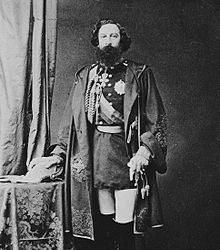
Manuel died on 2 July 1932, at Fulwell Park, Twickenham, Middlesex, England. There were no children from this marriage.
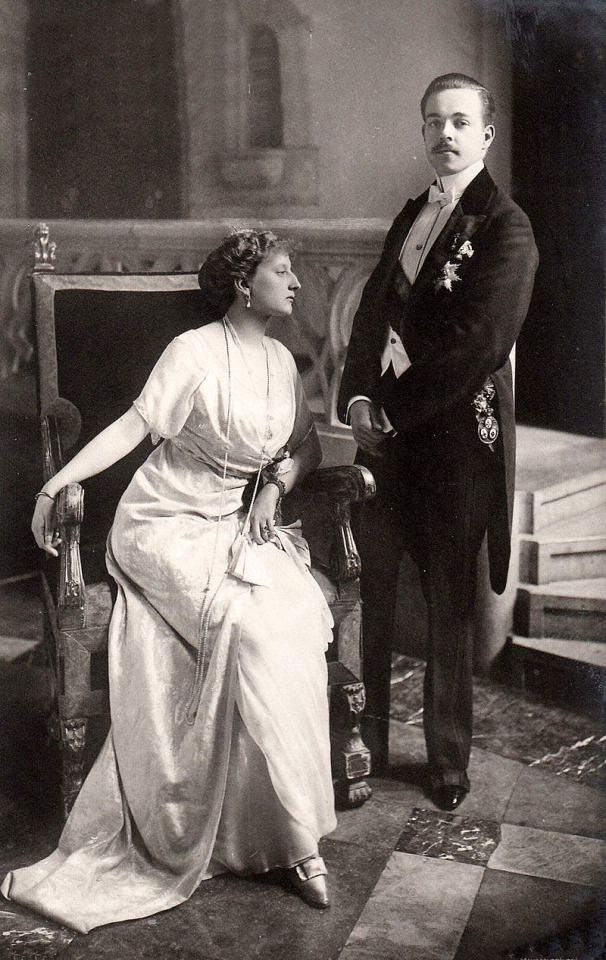
On 23 April 1939, Augusta Victoria married her second husband, Count Robert Douglas, the 13th head of the Swedish comital house of Douglas, lord of Langenstein Castle in Baden and heir of the Mühlhausen fideicommiss/entail (the eldest son of Count Ludvig Douglas).

The bride was almost forty-nine years old and the groom fifty-nine. There were also no children from this marriage. Douglas died on 26 August 1955. Augusta died at Eigeltingen, Baden-Württemberg, Germany, aged 76.
2 notes
·
View notes